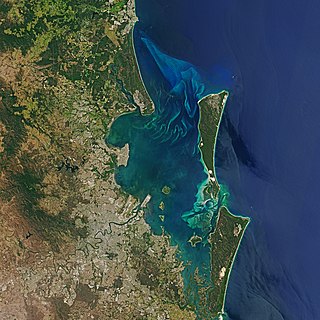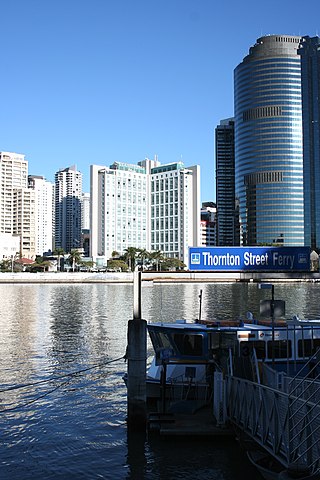Related Research Articles

Moreton Bay is a bay located on the eastern coast of Australia 14 kilometres (8.7 mi) from central Brisbane, Queensland. It is one of Queensland's most important coastal resources. The waters of Moreton Bay are a popular destination for recreational anglers and are used by commercial operators who provide seafood to market.

Moreton Island (Mulgumpin) is an island on the eastern side of Moreton Bay on the coast of South East Queensland, Australia. The Coral Sea lies on the east coast of the island. Moreton Island lies 58 kilometres (36 mi) northeast of the Queensland capital, Brisbane. 98% of the island is contained within a national park and a popular destination for day trippers, four wheel driving, camping, recreational angling and whale watching and a 75-minute ferry ride from Brisbane. It is the third largest sand island in the world. Together with K'gari, Moreton Island forms the largest sand structure in the world. It was the traditional country of the Ngugi before settlement.

Stradbroke Island, also known as Minjerribah, was a large sand island that formed much of the eastern side of Moreton Bay near Brisbane, Queensland until the late 19th century. Today the island is split into two islands: North Stradbroke Island and South Stradbroke Island, separated by the Jumpinpin Channel.

North Stradbroke Island, colloquially Straddie or North Straddie, is an island that lies within Moreton Bay in the Australian state of Queensland, 30 kilometres (19 mi) southeast of the centre of Brisbane. Originally there was only one Stradbroke Island but in 1896 it split into North Stradbroke Island and South Stradbroke Island separated by the Jumpinpin Channel. The Quandamooka people are the traditional owners of North Stradbroke island.

Bribie Island is the smallest and most northerly of three major sand islands forming the coastline sheltering the northern part of Moreton Bay, Queensland, Australia. The others are Moreton Island and North Stradbroke Island. Bribie Island is 34 kilometres long, and 8 kilometres at its widest. Archibald Meston believed that the name of the island came from a corruption of a mainland word for it, Boorabee meaning koala. However, the correct Joondaburri name for the island is in fact Yarun.

Dunwich is a town and locality on the western side of North Stradbroke Island in Queensland, Australia. Dunwich is part of the Redland City local government area, administered from the bayside town of Cleveland on the Queensland mainland. In the 2021 census, the locality of Dunwich had a population of 737 people.

Pormpuraaw is a coastal town and a locality in the Aboriginal Shire of Pormpuraaw, Queensland, Australia. Pormpuraaw is an Aboriginal community situated on the west coast of Cape York Peninsula approximately halfway between Karumba and Weipa on the Edward River. It is 650 kilometres (400 mi) by road from Cairns. Pormpuraaw currently has a 4-man police station.

The article Ferry transport in Queensland provides both historical and current information relating to scheduled public passenger ferry services in Queensland. The first ferry started on 1 January 1843 at Russell Street with a service across the Brisbane River.

Deebing Heights is a residential and semi-rural southern suburb of Ipswich in the City of Ipswich, Queensland, Australia. In the 2021 census, Deebing Heights had a population of 3,960 people.

Great Palm Island, usually known as Palm Island, is the largest island in the Palm Islands group off Northern Queensland, Australia. It is known for its Aboriginal community, the legacy of an Aboriginal reserve, the Palm Island Aboriginal Settlement. The original inhabitants of the island were the Manbarra people, also known as the Wulgurukaba, who were removed to the mainland by the Queensland Government in the 1890s. The island is also sometimes referred to as Bwgcolman, which is the name given to the Aboriginal and Torres Strait Islander people from disparate groups who were deported from many areas of Queensland to the reserve in 1918, and their descendants.
An Aboriginal reserve, also called simply reserve, was a government-sanctioned settlement for Aboriginal Australians, created under various state and federal legislation. Along with missions and other institutions, they were used from the 19th century to the 1960s to keep Aboriginal people separate from the white Australian population. The governments passed laws related to such reserves that gave them much power over all aspects of Aboriginal people’s lives.

The Quandamooka people are Aboriginal Australians who live around Moreton Bay in Southeastern Queensland. They are composed of three distinct tribes, the Nunukul, the Goenpul and the Ngugi, and they live primarily on Moreton and North Stradbroke Islands, that form the eastern side of the bay. Many were pushed out of their lands when the English colonial government established a penal colony near there in 1824. Each group has its own language. A number of local food sources are utilised by the tribes.

Dunwich Cemetery is a heritage-listed cemetery at Bingle Road, Dunwich, North Stradbroke Island in the City of Redland, Queensland, Australia. It was built from 1847 to 1952. It is also known as One Mile Cemetery. It was added to the Queensland Heritage Register on 21 October 1992.

Deebing Creek Mission is a heritage-listed former Aboriginal reserve at South Deebing Creek Road, Deebing Heights, City of Ipswich, Queensland, Australia. It was built from c. 1887 to c. 1915. It is also known as Deebing Creek Aboriginal Home, Deebing Creek Aboriginal Mission, and Deebing Creek Aboriginal Reserve. It was added to the Queensland Heritage Register on 24 September 2004.

Purga Aboriginal Cemetery is a heritage-listed cemetery at Carmichaels Road, Purga, City of Ipswich, Queensland, Australia. It was added to the Queensland Heritage Register on 18 September 2008.
The Ngugi are an Aboriginal Australian people, one of three Quandamooka peoples, and the traditional inhabitants of Moreton Island.
Myora Mission was established as a mission station in 1892 in the Colony of Queensland, at Moongalba on Minjerribah. It became an Aboriginal reserve and "industrial and reform school" in 1896, was used as a source of cheap labour, and eventually closed in 1943.

Palm Island Aboriginal Settlement, later officially known as Director of Native Affairs Office, Palm Island and also known as Palm Island Aboriginal Reserve, Palm Island mission and Palm Island Dormitory, was an Aboriginal reserve and penal settlement on Great Palm Island, the main island in the Palm Island group in North Queensland, Australia. It was the largest and most punitive reserve in Queensland.
Paul Tripcony (1901–1975) was an Indigenous Australian and a collector of rare books and Aboriginal stone artefacts from Minjerribah, also known as Stradbroke Island.
Robert Vincent Anderson is an Australian Aboriginal elder and former union official.
References
- 1 2 3 Walker, Faith (20 April 1998). "Useful and Profitable: History and race relations at the Myora Aboriginal Mission, Stradbroke Island, Australia, 1892-1940". Memoirs of the Queensland Museum, Cultural Heritage Series. 1 (1). Brisbane: 137–175. ISSN 1440-4788 . Retrieved 27 February 2020.
- ↑ "Deebing Creek Mission (former)". Queensland Government. 20 January 2016. Retrieved 27 February 2020.
- ↑ "Palm Island". Queensland Government. 26 November 2014. Retrieved 24 February 2020.
- 1 2 Anderson, Robert V. (2001). "History, Life And Times of Robert Anderson: Gheebelum, Ngugi, Mulgumpin". doczz.net. Uniikup Productions. Retrieved 27 February 2020.
Community and personal history of a Ngugi Elder of Mulgumpin in Quandamooka, South East Queensland, Australia.